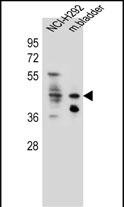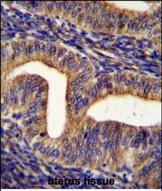GHSR Antibody (C-term)
Affinity Purified Rabbit Polyclonal Antibody (Pab)
- SPECIFICATION
- CITATIONS
- PROTOCOLS
- BACKGROUND

Application
| WB, IHC-P, E |
|---|---|
| Primary Accession | Q92847 |
| Other Accession | A5A4K9, Q95254, NP_940799 |
| Reactivity | Human, Mouse |
| Predicted | Pig, Rabbit |
| Host | Rabbit |
| Clonality | Polyclonal |
| Isotype | Rabbit IgG |
| Calculated MW | 41329 Da |
| Antigen Region | 326-357 aa |
| Gene ID | 2693 |
|---|---|
| Other Names | Growth hormone secretagogue receptor type 1, GHS-R, GH-releasing peptide receptor, GHRP, Ghrelin receptor, GHSR |
| Target/Specificity | This GHSR antibody is generated from rabbits immunized with a KLH conjugated synthetic peptide between 326-357 amino acids from the C-terminal region of human GHSR. |
| Dilution | WB~~1:1000 IHC-P~~1:50~100 E~~Use at an assay dependent concentration. |
| Format | Purified polyclonal antibody supplied in PBS with 0.09% (W/V) sodium azide. This antibody is purified through a protein A column, followed by peptide affinity purification. |
| Storage | Maintain refrigerated at 2-8°C for up to 2 weeks. For long term storage store at -20°C in small aliquots to prevent freeze-thaw cycles. |
| Precautions | GHSR Antibody (C-term) is for research use only and not for use in diagnostic or therapeutic procedures. |
| Name | GHSR |
|---|---|
| Function | Receptor for ghrelin, coupled to G-alpha-11 proteins. Stimulates growth hormone secretion. Also binds other growth hormone releasing peptides (GHRP) (e.g. Met-enkephalin and GHRP-6) as well as non-peptide, low molecular weight secretagogues (e.g. L-692,429, MK- 0677, adenosine). |
| Cellular Location | Cell membrane; Multi-pass membrane protein. |
| Tissue Location | Pituitary and hypothalamus. |

Thousands of laboratories across the world have published research that depended on the performance of antibodies from Abcepta to advance their research. Check out links to articles that cite our products in major peer-reviewed journals, organized by research category.
info@abcepta.com, and receive a free "I Love Antibodies" mug.
Provided below are standard protocols that you may find useful for product applications.
Background
This gene encodes a member of the G-protein coupled receptor family. The encoded protein may play a role in energy homeostasis and regulation of body weight. Two identified transcript variants are expressed in several tissues and are evolutionary conserved in fish and swine. One transcript, 1a, excises an intron and encodes the functional protein; this protein is the receptor for the Ghrelin ligand and defines a neuroendocrine pathway for growth hormone release. The second transcript (1b) retains the intron and does not function as a receptor for Ghrelin; however, it may function to attenuate activity of isoform 1a. Mutations in this gene are associated with autosomal idiopathic short stature.
References
Bailey, S.D., et al. Diabetes Care 33(10):2250-2253(2010)
Landgren, S., et al. Alcohol. Clin. Exp. Res. 34(9):1519-1524(2010)
Aghajanova, L., et al. Reprod Sci 17(9):823-832(2010)
Pinheiro, A.P., et al. Am. J. Med. Genet. B Neuropsychiatr. Genet. 153B (5), 1070-1080 (2010) :
Liu, C.Y., et al. Carcinogenesis 31(7):1259-1263(2010)
If you have used an Abcepta product and would like to share how it has performed, please click on the "Submit Review" button and provide the requested information. Our staff will examine and post your review and contact you if needed.
If you have any additional inquiries please email technical services at tech@abcepta.com.













 Foundational characteristics of cancer include proliferation, angiogenesis, migration, evasion of apoptosis, and cellular immortality. Find key markers for these cellular processes and antibodies to detect them.
Foundational characteristics of cancer include proliferation, angiogenesis, migration, evasion of apoptosis, and cellular immortality. Find key markers for these cellular processes and antibodies to detect them. The SUMOplot™ Analysis Program predicts and scores sumoylation sites in your protein. SUMOylation is a post-translational modification involved in various cellular processes, such as nuclear-cytosolic transport, transcriptional regulation, apoptosis, protein stability, response to stress, and progression through the cell cycle.
The SUMOplot™ Analysis Program predicts and scores sumoylation sites in your protein. SUMOylation is a post-translational modification involved in various cellular processes, such as nuclear-cytosolic transport, transcriptional regulation, apoptosis, protein stability, response to stress, and progression through the cell cycle. The Autophagy Receptor Motif Plotter predicts and scores autophagy receptor binding sites in your protein. Identifying proteins connected to this pathway is critical to understanding the role of autophagy in physiological as well as pathological processes such as development, differentiation, neurodegenerative diseases, stress, infection, and cancer.
The Autophagy Receptor Motif Plotter predicts and scores autophagy receptor binding sites in your protein. Identifying proteins connected to this pathway is critical to understanding the role of autophagy in physiological as well as pathological processes such as development, differentiation, neurodegenerative diseases, stress, infection, and cancer.



